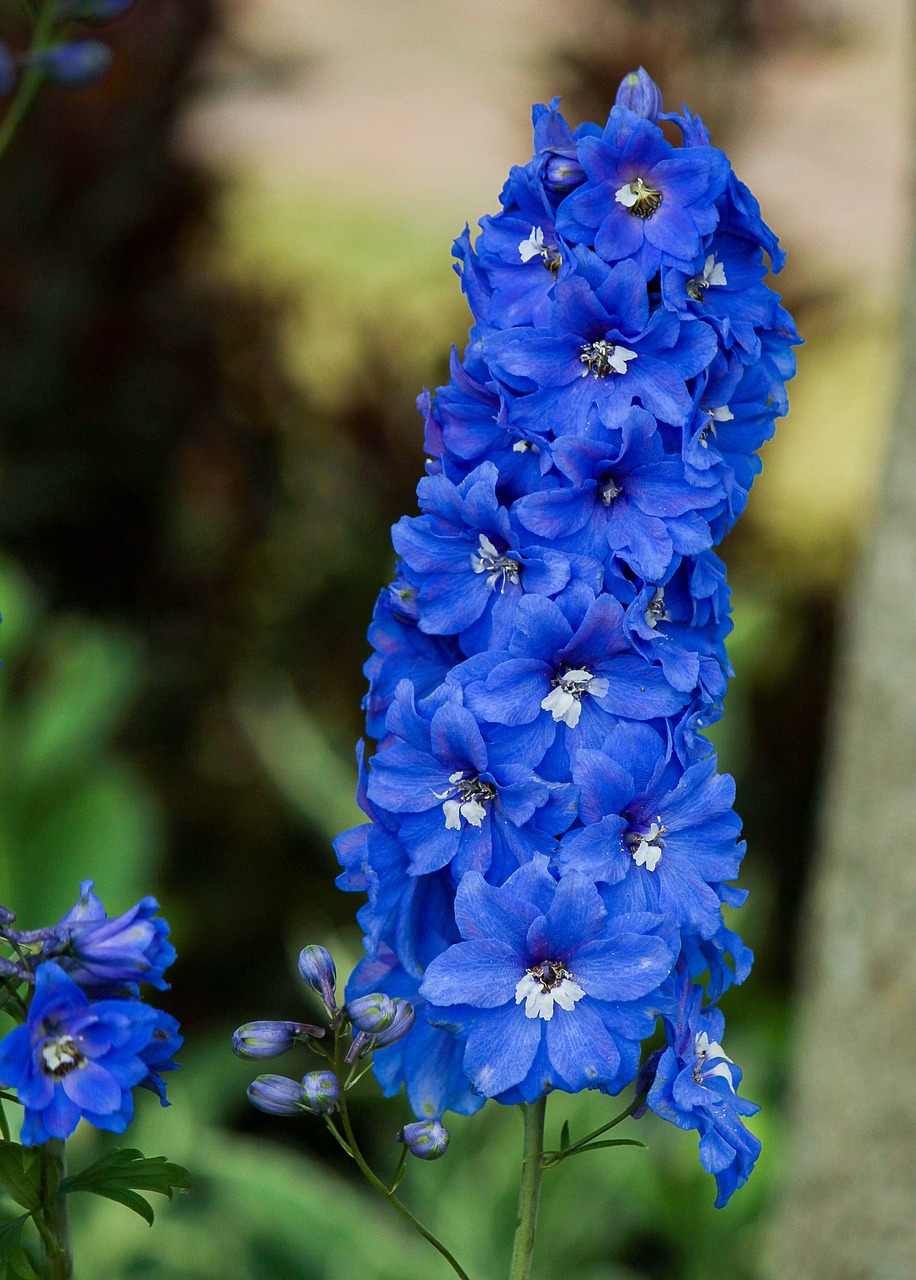Learn the Tips on Growing Cucumbers Vertically in Small Spaces in easy-to-follow simple steps in this comprehensive guide.
Read this informative guide and find Tips on Growing Cucumbers Vertically in Small Spaces to get a bountiful fresh harvest.
Why Should You Grow Cucumbers Vertically?

When you grow cucumbers horizontally on the ground, they typically occupy an area of 10-20 square feet as the plants spread out across the surface. However, smaller and more compact varieties require only 1/3 of this space, yet they yield a smaller quantity of fruits.
Vertical planting of climbing vine-type cucumber varieties proves to be highly productive as they require a mere 1-2 square feet of space. These plants utilize a trellis or cage for support as they climb upwards.
Check Tips to Grow a Papaya Tree
Benefits of Growing Cucumbers Vertically
Growing cucumbers vertically offers the advantage of reducing the common issue of fruit rot, which often occurs when cucumbers are grown in the traditional manner. Fruit rot is caused by extended exposure of the fruits to moist soil.
By allowing cucumber vines to grow vertically, the air circulation around the plant is enhanced, effectively protecting against fungal diseases.
Opting for vertical growth of cucumber plants enables their leaves to maximize sun absorption, leading to robust plant growth and the development of larger cucumbers. Additionally, this approach offers the advantage of effortless and timely fruit harvesting.
How to Grow Cucumbers Vertically in Small Spaces
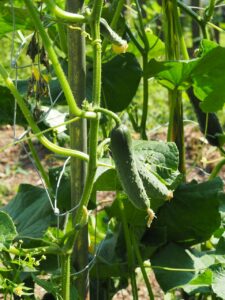
1. Select an Area with Right Conditions
When considering how to grow cucumbers vertically, it is crucial to select a location with minimal wind exposure. This choice enhances the stability of your pergola or trellis and contributes to the overall prosperity of the cucumber plant. Opt for a sunny area that provides ample sunlight and ensure that the soil is well-drained, loose, and deep for optimal growth conditions.
A wide range of ideas are available for growing cucumbers vertically. These include the utilization of living walls, vegetable garden trellises, pergolas, and arches, among others.
Pergolas: An excellent option for adding shade to a patio, and when combined with other climbing plants, they can create a beautiful mix of greenery.
A-frames: Provide a highly stable structure for growing cucumbers vertically, but they are better suited for larger plots and vegetable gardens due to their space requirements.
Teepees: A compact approach suitable for growing cucumbers vertically in greenhouses, containers, and outdoor spaces.
Trellises: The traditional and time-tested method for vertical cucumber planting.
Arches: Chosen for their aesthetic appeal, but it is crucial to ensure their stability before training the cucumber plants.
2. Propagation and Planting of Cucumbers
- You can sow cucumber seeds directly in the desired area or in small pots.
- Cover the seeds with approximately 1 inch (2 cm) of soil.
- Once the seedlings have germinated and developed a few true leaves, transplant the strongest and healthiest ones into larger pots or the frost-free ground during spring or summer.
- It is ideal to perform the transplant when the soil temperature reaches at least 65°F (18°C) or higher.
In regions with a tropical or subtropical climate, it is possible to grow cucumbers throughout the year.
Similar to tomatoes, cucumber plants are heavy feeders. Therefore, it is essential to adequately prepare the soil before planting by incorporating well-rotted manure and compost.
3. Tie in Cucumbers To Grow Them Vertically
As your cucumber plants begin to grow taller, secure them to the pergola or trellis using ties, and repeat this process as they continue to grow.
Read Tips To Grow Mango Tree In A Pot
How to Grow Cucumbers Vertically on a Trellis
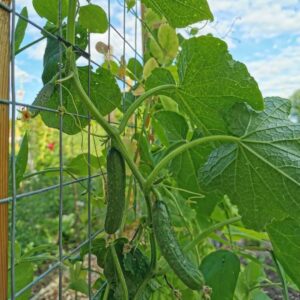
Select a sturdy trellis that stands at a height of 5 to 6 feet and is resistant to toppling. When growing climbing cucumber varieties, using an “A-frame trellis” allows the plants to ascend and descend from it effortlessly. Alternatively, coir ropes can be used to guide the growth of the vines.
TIP: Before planting your courgette plants in the ground, make sure to construct your trellis. This can involve attaching a wooden trellis to a fence or securing your A-frame trellis within a designated bed.
Once you have completed the necessary preparations, you are now prepared to transplant your cucumber plants.
- Place the plant evenly spaced along your trellis or A-frame, ensuring a minimum of 12 inches between each plant.
- Subsequently, use garden twine to secure the plants to designated sections of the trellis gently.
- Maintain this practice as your cucumber plant develops, as it will promote vertical growth.
Note: To grow cucumbers vertically, train vines to climb a trellis or support structure. Securely attach them with soft ties or twine to maintain an upright position and prevent sprawling.
Learn How to Grow Ashwagandha in the Home and Garden
How to Grow Cucumbers Vertically in a Container Garden
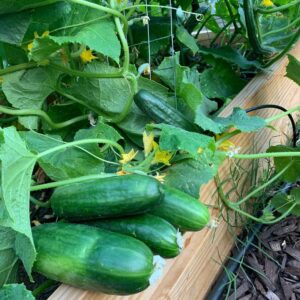
For vertical cucumber container gardening, it is advisable to choose generously sized containers that exceed a depth and width of 12 inches. Specifically, if you opt for a non-bushy vine variety, go for an even larger pot, ideally around 18 inches in size.
- The number of cucumber plants that can be grown in a container of this size depends on the specific variety being planted.
- Vining varieties, which grow tall and have extensive root systems, require larger pots.
- On the other hand, bushier types are shorter and can be successfully cultivated in standard-size pots.
Read Best Tips to Make Pepper Plants Hotter
How to Grow Cucumbers Vertically on a Pergola

- An alternative approach to vertically growing cucumbers involves training them over a pergola.
- The method of growing cucumbers on a pergola closely resembles vertical growth on a trellis.
- Opting for a pergola provides the added advantage of easy harvesting, as the cucumber fruits naturally hang down from the pergola’s roof.
- Begin by planting your cucumber plants at the base of the pergola, securely fastening them with garden twine.
- As the plants grow, continue tying them to the pergola structure, gradually guiding their upward growth and creating a roof-like canopy.
- When the cucumbers are ripe and ready for harvest, simply snip the stem connecting them to the plant above the fruit.
Tips on Growing Cucumbers Vertically
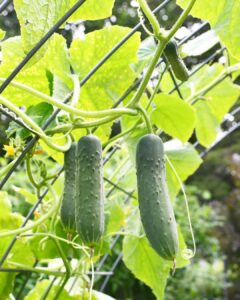
Position
Cucumbers thrive in warm and sunny locations with minimal wind while still maintaining good air circulation. They prefer temperatures above 50°F (10°C), and the ideal temperature range for growth is between 60°F and 95°F (15°C and 35°C).
Soil
Cucumbers prefer soil that is well-drained, loose, and deep. It should be rich in organic matter and have a neutral pH. When growing in containers, you can use a potting mix supplemented with high-quality compost or organic cattle manure.
Watering
Consistent and thorough watering is crucial for a bountiful cucumber harvest, thanks to its high water content. When watering, be careful not to wet the foliage as it can promote fungal diseases such as mildew.
Fertilizer
Cucumbers have high nutritional needs and benefit from ample nutrients to support their growth and abundant yield.
- Opt for organic fertilizers such as compost, worm castings, or well-rotted manure. They will enhance soil structure, provide essential nutrients, and encourage a thriving soil microbiome.
- To apply these fertilizers, mix them into the soil during planting.
- Alternatively, you can apply them around the base of the plant during the mid-season or sprinkle them on top of the soil, followed by a thorough watering.
- Another option is to apply a balanced liquid fertilizer, such as a 10-10-10 formula, and use it every two to three weeks throughout the growing season.
- Follow the manufacturer’s guidelines to prevent over-fertilization, which can cause nutrient burn and other issues for the plants.
- If desired, you can reduce the strength of the fertilizer by providing only half of the recommended dosage as a precautionary measure.
- Watering the plants adequately following fertilization is crucial for facilitating the penetration of nutrients into the soil and their absorption by the plant’s roots.
- Another alternative for fertilization involves incorporating all-purpose slow-release fertilizer into the soil during the planting process.
- Subsequently, when the plant begins to flower, applying a side-dressing of aged manure can be beneficial.
Mulching
When cultivating cucumbers in your garden, it is essential to apply mulch around the plant’s base. This practice helps enhance the soil’s moisture retention capacity.
Support
As cucumbers continue to develop, their weight increases, making it necessary to provide extra support to avoid the trellis or support structure from collapsing. One option is to utilize slings crafted from cloth or netting to bolster the fruit and prevent it from detaching from the vine.
Alternatively, tomato cages, stakes, or other support structures can be employed to maintain the vines in an upright and stable position.
Pests and Diseases
Cucumber plants are susceptible to various diseases such as anthracnose, powdery mildew, downy mildew, and leaf spot. Additionally, it is important to be vigilant for common garden pests like aphids, spider mites, whiteflies, and others, as they can also threaten your cucumber plants.
To decrease issues related to diseases and pests, implement the following measures:
- Regularly inspect your plants to identify early signs of disease or pest infestation.
- Ensure adequate air circulation around the plants, as it helps reduce the risk of fungal diseases.
- Avoid overhead watering, as it can promote the spread of diseases. Instead, water the plants at the base to keep the foliage dry.
- Opt for cucumber varieties that are resistant to common diseases or pests prevalent in your area.
- Practice crop rotation by avoiding planting cucumbers in the same location for more than 2-3 years in the garden bed.
- This helps minimize the buildup of diseases and pests in the soil.
Follow Tips to Grow Chia Seeds at Home
Harvesting Cucumbers

When and How to Harvest Cucumbers?
The harvesting time for cucumbers typically ranges from 60 to 90 days, although it can vary depending on the specific variety and growing conditions. It is important to pick the cucumbers when they have reached a sufficient level of development. Look for cucumbers that are firm to the touch, smooth in appearance, and offer a crunchy texture when tasted.
It is advisable not to allow the fruits to become overripe, as they may lose their desired qualities.


